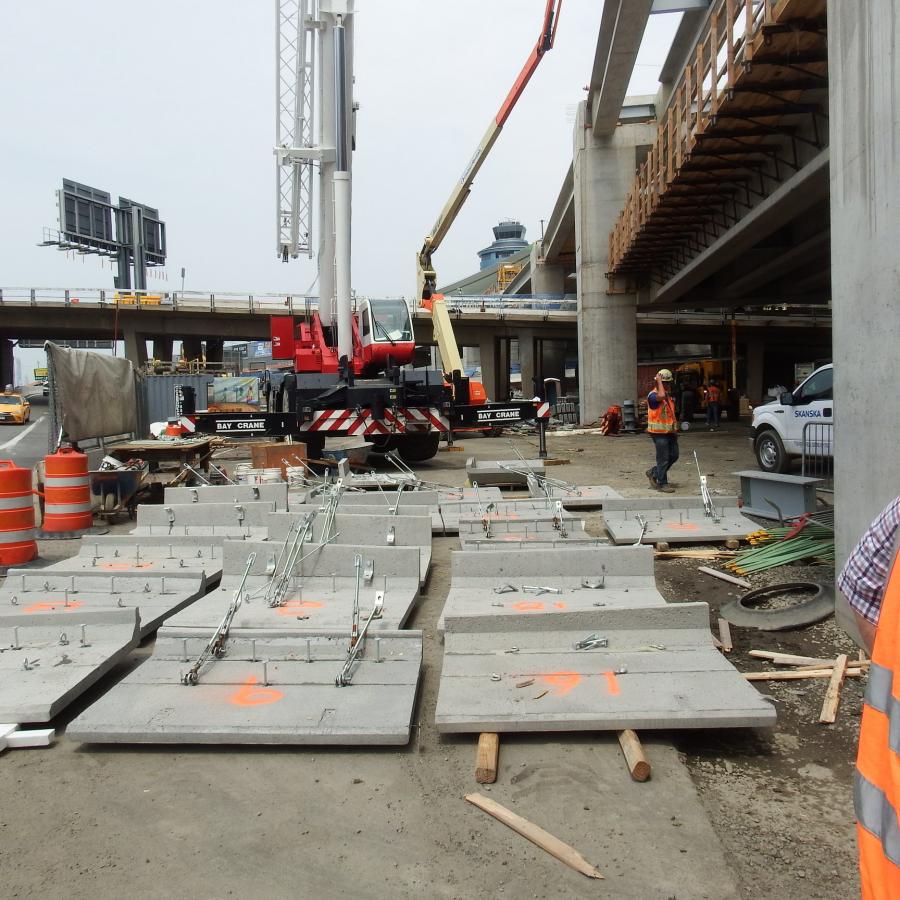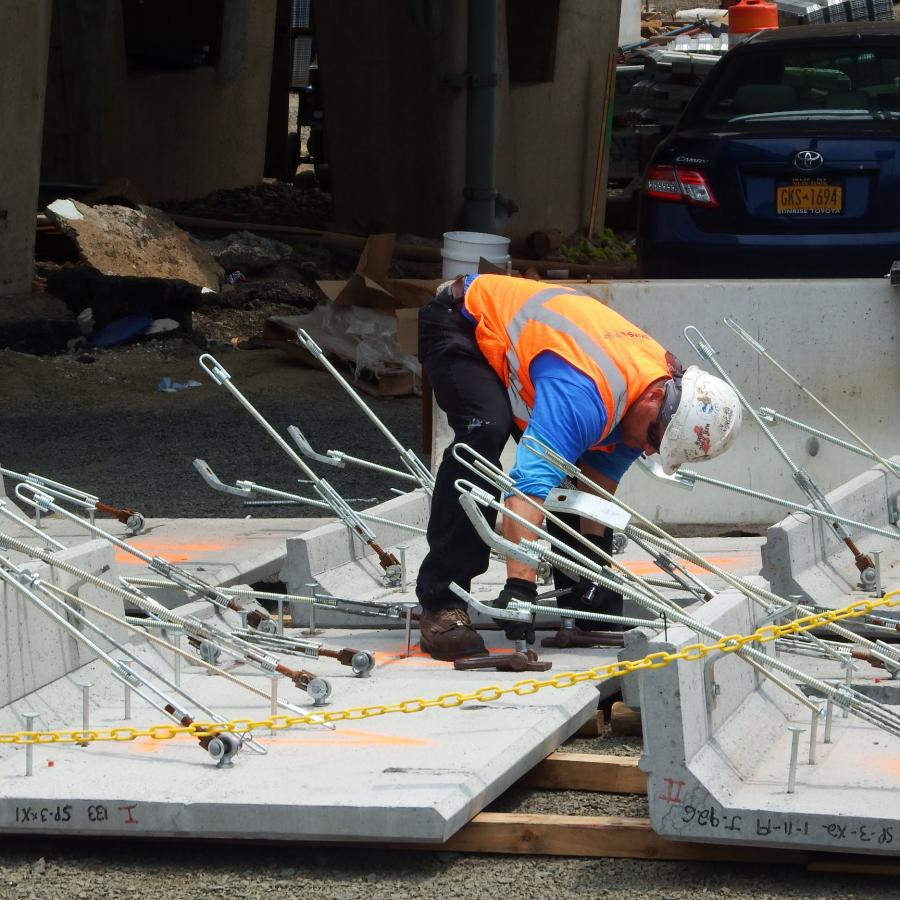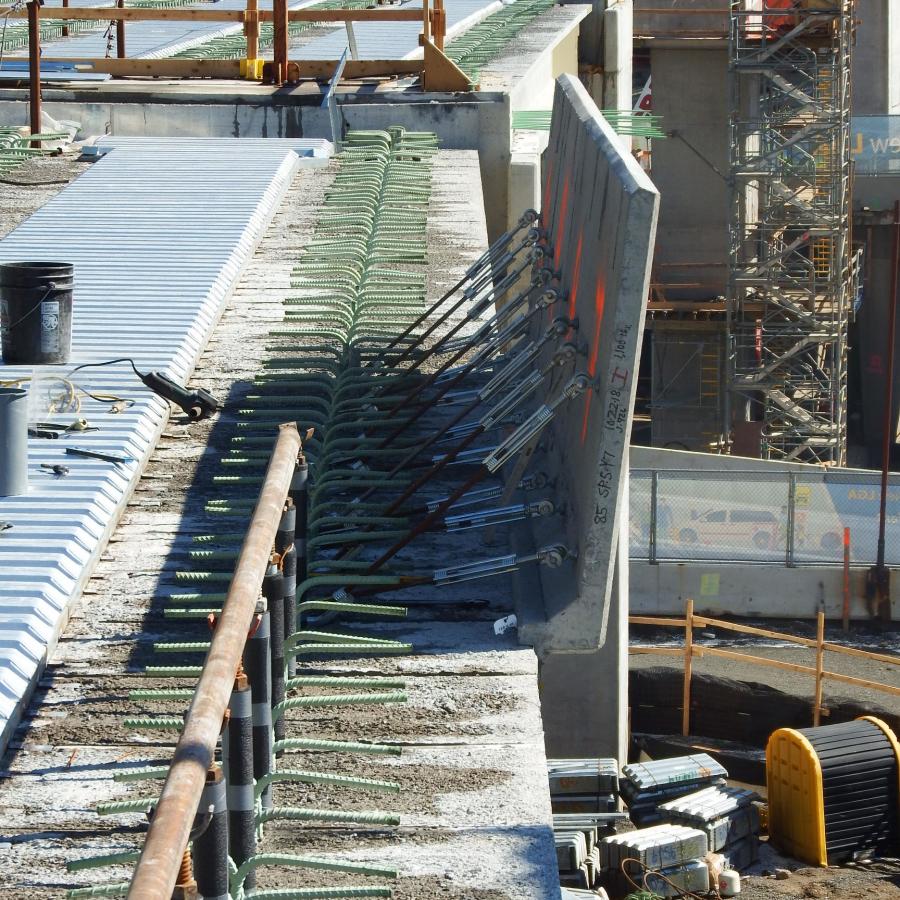Walsh Construction and Skanska USA, operating as the Design-Build Joint Venture of Skanska-Walsh on this project for the Port Authority of New York and New Jersey (PANYNJ), decided to put Stay-In-Place-Fascia-Forms (SIPFF) to work on two bridges that carry vehicular traffic between terminals. (Precasteel photo)
Bringing a new product to market is never an easy task, especially when it is being supplied to a large joint venture working on a high-profile project like the $8-billion Central Terminal Replacement Project at New York's LaGuardia Airport.
Walsh Construction and Skanska USA, operating as the Design-Build Joint Venture of Skanska-Walsh on this project for the Port Authority of New York and New Jersey (PANYNJ), decided to put Stay-In-Place-Fascia-Forms (SIPFF) to work on two bridges that carry vehicular traffic between terminals.
Addressing 'Rusting of America'
This precast fascia form was patented by Precasteel LLC of Skillman, N.J. It is essentially an L-shaped piece of precast concrete designed to stay in place and serve as a form for the bridge deck pour and subsequent barrier pour.
Precasteel is the brainchild of Gary M. Dinmore. It was conceived based on a trend he noticed over the course of 20 years working on numerous New York City bridge projects with bridge bracket and conventional overhang construction issues.
Dinmore recalled learning about the graying of America — caused by the aging of the Baby Boomers — during a Penn State Economics class. He didn't recognize the significance of this trend at the time and the window of opportunity eventually closed. Despite the missed opportunity it left him looking for another trend, which he discovered while inspecting bridges early in his career.
"Rather than the graying of America," Dinmore recalled, "I started thinking of the rusting of America and the fact that our bridges are getting old and need to be replaced."
Recognizing that the seemingly endless inventory of bridges would eventually have to be fixed, especially those built in the post-World War II era, he set out to identify market inefficiencies.
Dinmore found what he was looking for in bridge overhang brackets. During his deployment to Lebanon as a member of a Special Forces ‘A' Detachment, he saw stone aqueducts dating back to the B.C. era with overhangs reportedly constructed in a similar manner with timber falsework for support. He believed there had to be a better way because of advancements in modern materials where concrete can nearly mimic the strength of mild steel — hence the name PRECASTEEL.

Skanska-Walsh crews offloaded and moved the sections to a staging area where workers installed the hardware before hoisting them to the bridge deck one by one with a small crane. (Precasteel photo)
Barriers Cleared at LaGuardia
Design work at LaGuardia was done in 2018, but construction unfolded in 2019. Precasteel had done research and development and built prototypes and full-scale mock-ups in the past, but this was the first actual job.
"This is the first production job on a permanent structure," said Dinmore. "It was probably the hardest project we could have asked to start with."
There could be no production mistakes on a project of this magnitude. Precasteel had to slip form a full-scale mock-up at the Lehighton, Pa., facility of its precast supplier, J&R Slaw. It also had to clear the design review process under the scrutiny of WSP USA and HOK.
LaGuardia was challenging on several levels. It was a large project requiring approximately 1,800 linear ft. of SIPFF panels for two structures, each with nine 100-ft. spans of varying soffit widths and two spans with curvature. It also required a deviation from the standard shape. The architect wanted a "Lazy L" shape for aesthetic reasons.
The placement of light blisters also required the soffits to be bumped out from 30 to 44 in. The fact that one bridge used prestress concrete Bulb T Beams and the other steel girders wide flange beams also required Precasteel to modify hardware during the project to accommodate the geometry of the two different bridge beam types.
The Precasteel design allowed for a ¼-in. gap between panels to provide some construction tolerances since no closure pours were allowed on the structures to avoid contrasts in color. It also helped with the camber, which is essentially the upward deflection built into the bridge beam during fabrication. The camber was necessary for the structure to lay level after the entire deadload was applied.
Dinmore confirmed that the gap closed and the panels settled into position along the beams' edge without consequence when Skanska-Walsh poured the deck.
"Everything behaved the way we anticipated," he said. "The ¼-inch gap gave them a lot of leeway in the field."
One unexpected benefit was that the gap was hidden in the shadows of the chamfered edges upon completion, which made the façade even more aesthetically pleasing.
The gap also eliminated rework and scheduling issues for Skanska-Walsh. In one instance, a panel was damaged prior to installation and needed to be replaced. The crew was able to continue setting panels, butting them tightly together, and skipping over the damaged panel location until a new one could be installed. They used a flat bar to make some minor adjustments to adjacent panels and the final panel fit perfectly.
"You don't have to stop just because you don't have one piece of the puzzle," said Dinmore. "That ¼-inch gap helped. It gave the contractor plenty of room to drop it in without banging against the other panels."

Gary M. Dinmore conceived Precasteel based on a trend he noticed over the course of 20 years working on numerous New York City bridge projects with bridge bracket and conventional overhang construction issues. (Precasteel photo)
Deviating from Original Design
Precasteel was originally designed with a 90-degree angle. The architect at LaGuardia, however, was going for a different aesthetic. The vertical axis tilts back as a result, which Dinmore dubbed the "lazy L."
Aesthetics are, in fact, what drove the specification of Precasteel over conventional methods at LaGuardia. The tilted back panel would have required extra bracing, whereas precast concrete was able to be formed without additional costs.
The architect discussed the use of white concrete for the facade, but Precasteel suggested that standard concrete would be a close match. They worked with its precast supplier J&R Slaw to provide samples and it was approved.

Skanska-Walsh workers waited on the bridge deck as sections were floated into place like puzzle pieces. (Precasteel photo)
Problem With Bridge Brackets
"There are inherent problems with bridge brackets," said Dinmore. These triangular brackets, consisting of steel and heavy-duty plywood, jut out from the edges of the bridge to provide support during deck construction.
"The conventional alternative to using bridge brackets," he continued, "is fraught with wasted money and materials."
Dinmore spent 20 years working on high-profile infrastructure projects in Metropolitan New York, the last 6 years as chief engineer for a Fortune 500 heavy civil contractor. He saw money wasted on transportation, unnecessary tasks, and the disposal of plywood after bridge brackets were disassembled.
Most contractors don't own bridge brackets that conform to the requirements of today's construction and those that do often spend time digging them up in the yard for the next project only to find that they have fallen into disrepair.
"Every time I would find an area where we were losing money, it traced back to these bridge brackets," Dinmore said. "The money was going everywhere except into the structural deck where it belonged."
The closer spacing of these costly brackets has exacerbated the problem, according to Dinmore. Contractors used to set them around 36 to 48 in. apart.
"They are now putting them much closer and that gets very, very expensive," he said. "Precasteel eliminates the need for brackets altogether."
Bridge brackets also can impact paving quality. The proximity of the bridge paver screed rail to the brackets causes them to deflect during paving and creates a wave, or a washboard affect, in the concrete deck along the barrier that often collects water and eventually scales. The damage is often discovered after the project is completed but the warranty has not expired, leaving the contractor with the unexpected cost of diamond grinding or deck replacement depending upon available concrete cover over the deck reinforcing steel.
Precasteel is not subject to this issue since the paver screed rail is located along the centerline of the fascia beam as opposed to the panel itself.

Skanska-Walsh workers had to have all the hardware on before they flew the panels up to the bridge deck to achieve the production rate of one minute per linear foot. The hardware on each panel includes swivel hoist rings (aka swivel lifts), and two eye bolts, primary ties and secondary ties. (Precasteel photo)
Precasting, Installing Precasteel
J&R Slaw produced the panels at its Lehighton plant with Precasteel performing periodic quality inspections for quality assurance, especially on the first bridge known as the Frontage Road Structure (FRS). No plant inspectors were present from PANYNJ; although the authority did station an inspector at the plant for ramp L29, the second of the structures. All Precasteel sections were 5 ft. long and 1,000 lbs. on average.
"It was shown in the design that soffit widths varied requiring each panel to be custom," Dinmore recalled. "At the end of the day Slaw did a really good job, especially on the geometry, because everything fit like a glove."
There was no specification for Precasteel so guidelines from the Architectural Precast Association (APA) were adopted early on. The recommended slender ratio dictated an increase in thickness from 2 ½ to 3 in. and a minimum concrete compression strength of 6,500 psi to avoid shrinkage and stress cracks.
All Precasteel sections were palletized, stacked on a flatbed trailer and shipped off to LaGuardia. Upon arrival, Skanska-Walsh crews offloaded and moved the sections to a staging area where workers installed the hardware before hoisting them to the bridge deck one by one with a small crane.
"They had to have all the hardware on before they flew the panels up," said Dinmore. "That was the only way to achieve the production rate of one minute per linear foot."
The hardware on each panel includes swivel hoist rings (aka swivel lifts), and two eye bolts, primary ties, and secondary ties. Skanska-Walsh workers waited on the bridge deck as sections were floated into place like puzzle pieces. The panels featured a notch slightly greater than 90-degrees along the bottom longitudinal edge that rested directly upon the top outboard flange of the fascia beam.
Once the connection was engaged, a worker bolted the ties onto a threaded stud shot on the beam and tightened it. The swivel lifts were disconnected from the panel and flown back down with the rigging on the crane hook and the process was repeated on the next section. Another set of swivel lifts were used on the next section to save time.
The plus 90-degree angle of the notch, better known as the bird's beak, allows a panel to be set at almost any angle without any chipping or breakage. And it fits nearly any member that might be used for a bridge fascia beam. The only requirement is a 90-degree edge along the beam, whether curved, straight, concrete, or steel. No positive connection is made between the notch and the beam's flange.
"The notch is the secret sauce," said Dinmore. "It's what makes Precasteel work."

Precasteel was originally designed with a 90-degree angle. The architect at LaGuardia wanted to achieve a different aesthetic so the vertical axis tilts back as a result. (Precasteel photo)
Safer than Conventional Method
Precasteel was initially designed to improve productivity, but it turned out that the conventional method of installing parapets was causing safety headaches.
Dinmore was approached by several insurance agents at the 2018 Utility & Transportation Contractors Convention of New Jersey (UTCA NJ) in Atlantic City. All were seeing frequent safety claims associated with the improper installation of bridge brackets or the vulnerability to wind uplift causing damage prior to concrete placement. The bracket and plywood are often unsecured before concrete is poured, acting like a kite that can get blown upward by moderate to heavy winds.
"This is a typical scenario for a lot of contractors," Dinmore said. "It has probably happened to most of them at least once."
Many owners now specify that a cable needs to be threaded through the brackets to prevent the brackets from falling into the roadway below after uplifting winds rip the entire forming system off the bridge.
Skanska-Walsh crews were able to work safely from the bridge deck at LaGuardia, focusing on connecting the hardware properly. Each Precasteel section is equipped with two ties, one of which is redundant. Even in a worst-case scenario where a heavy load bangs into a panel, it would break rather than fall. This was proven on the last barrier pour on a section installed more than 6 months before barrier concrete placement.
Precasteel panels at LaGuardia were designed to withstand all anticipated construction and OSHA loads with up to six times the factor of safety on deck pours and two times on barrier pours; the current standards have increased safety factors even more to facilitate the usage of pick brackets attached to the panels on the inside to allow workers to move freely up and down the line of panels and to account for reverse stresses that could be implied on the panels during slip forming operations.
At 42 inc. tall from the soffit top, the installed Precasteel panels eliminated the need for fall protection, which is required when using bridge brackets. This not only prevented tripping and other nuisances that arise when connecting self-retracting lifelines, but also improved productivity for the trades waiting behind Skanska-Walsh's panel installation crew.
The time savings gained by not having to tie off were incremental at the end of the project but the real schedule booster was not having to come back after the panels were installed; hence the Precasteel motto, "Set ‘em & Forget ‘em!."
Skanska-Walsh finished successfully installing all Precasteel panels on the Central Terminal project in September 2019, and Delta Airlines had designed approximately 1,700 linear ft. of Precasteel panels into the project at its neighboring terminal. DeFoe Construction Inc. had been slated to perform the work in early 2020; however, the pandemic caused precast plant closures that resulted in the need for conventional construction. The fact that Delta Airlines incorporated the panels into its design after witnessing the ease of construction and aesthetically pleasing finish is a testament to Precasteel.
Dinmore was proud to see Precasteel reaching the tipping point after more than 20 years of seeking a solution and six years researching and developing the concept.
"My goal is to see Precasteel on bridges in every state across this great nation and eventually the world," he said. "I'm thankful to Skanska-Walsh for recognizing the simplicity and potential of my idea and putting it to the ultimate test at LaGuardia."
But Dinmore does not consider himself a sales person or a politician, nor does he have the distribution or manufacturing facilities in place that are needed to launch his product on the grand scale it deserves. Now that proof of concept is behind him and the Infrastructure Bill is imminent, he's looking for a helping hand to reach his goal of getting SIPFF's on bridges across the United States.
For more information, visit www.precasteel.com.

Precasteel allows the paver screed rail to be located along the centerline of the fascia beam as opposed to the panel itself, which eliminates the paving quality issues that can occur when using bridge brackets. (Precasteel photo)
Today's top stories
























